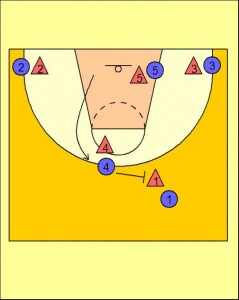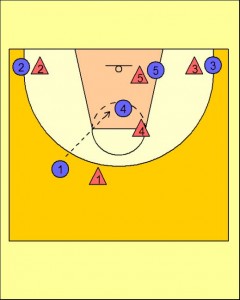Introduction to the Pick and Roll Offense
Using screens has always been part of any competent modern coach’s offensive game plan, regardless of what level they are coaching at. However, the on-ball screen became widely popular in the 1980’s. Teams focused on the pick and roll offense to utilise the athleticism of players or isolating two players to maximise the tactics potency. A great exposé of the Pick and Roll Offense were Point Guard John Stockton and Power Forward Karl Malone who ran the play so often and so smoothly that Malone garnered the nickname: “The Mailman”.
Instead of simply using screens to free up shooters, on-ball screens became a popular way to initiate an offense and give players an opportunity to receive the ball where they could be effective. It has since become a staple at the NBA level, with pick and rolls accounting for nearly half of an average team’s offensive game plan. In the Euroleague the pick and roll offense is utilised in a different tactical strategy with players utilising the movement to create open long range jump shots which are nearly impossible to defend with a capable shooter.
The pick and roll offense is popular because it’s both simple and effective. You don’t need a player with tremendous talents to run a successful pick and roll. The premise of the pick and roll is to unbalance the floor—instead of the defence having two big men defending the bucket, one of them is dragged out of the keyway in order to defend the pick and roll. This gives the ball handler on offense a number of different options to choose from, based on both how the defence plays the screen and the skillset of the ball handler. Options such as the ball handler driving into the keyway for a jump shot or lay-up or hitting the screener rolling to basket are just some of the options available in this two man game.
The advantages of the pick and roll offense lies in its ease of use. The pick and roll can be executed from either side of the floor, with either guard handling the ball, and with any frontcourt player rolling to the basket. If a coach has a guard who is a strong shooter off the dribble, they are an excellent candidate to run the pick and roll. Likewise, if a coach has a strong frontcourt player who is a good finisher at the rim, they are a great option to set the screen and receive the roll pass. The pick and roll offense is also very versatile. It can be utilised as a focus point for an offense or as a terminal option within many offensive systems.
The pick and roll offense isn’t traditionally strong against zone defences, which can neutralize the lanes created by the post defender coming out to the three point line. Against zone defences, the ball handler can be stifled and his passing lanes cut off. The pick and roll is not usually used against zone defences, and this is then a suggested option for teams facing a competent opposition team utilising the pick and roll offense.
The simplest way to defeat a pick and roll offense would be to go zone defence. This change up in some instances will be enough to render the strategy useless and force the opposition to change tactics.
The premise of the pick and roll is to create high percentage shots, and successfully defending it means lowering the shot percentage of the offensive players. Many times, this means knowing the strengths of the offensive players. If the screener is a great finisher, while the guard isn’t a good shooter, the defence might send both defenders with the screener, trying to prevent a roll to the basket. If the inverse is true, and the screener isn’t a high percentage finisher but the guard is a good shooter, the post defender might hedge longer on the ball screen to prevent the guard from setting up for a shot.

The Pick and Roll Offense is an option that can be executed as an offensive system in its own right or as an option within many different offensive philosophies.
The formation for this example is a one-four set up for the offensive team.
In this example the Pick and Roll Offense begins with the one (1) starting with the ball on a sideline.
The post player (Four) on the weak side of the floor sprints up the keyway and sets an on-ball screen on the ball handler’s (One) defender.
It is suggested the screen is executed to the strong side of the split line so the ball handler can turn off the screen straight to the basket.

The ball handler (One) can either set up his defender by walking in the opposite direction from the screen (away from the screen), or giving the defender a hesitation move before using the screen.
The ball handler must wait for the screen to be set (stationary) before starting to initiate the pick and roll movement.
It is vital that the screener and dribbler rub shoulders when executing the screen the try and limit the defending of the tactic.
Once coming off the screen the dribbler (One) will attempt to drive into the keyway for a jump shot or lay-up. In this scenario the screener can flare to space and attempt not to crowd the driving lane for the dribbler.

If the defenders manage to block off the driving lane for the dribbler the screener (Four) will roll to the front of the basket a receiver spot and into looking for the pass.
Other reads available for the offensive team is the slip the screen if both defenders are above the baseline shoulder of the screener. In this scenario a verbal cue is given by the dribbler and the screener rolls to the basket without the dribbler moving.


